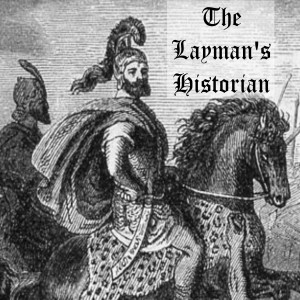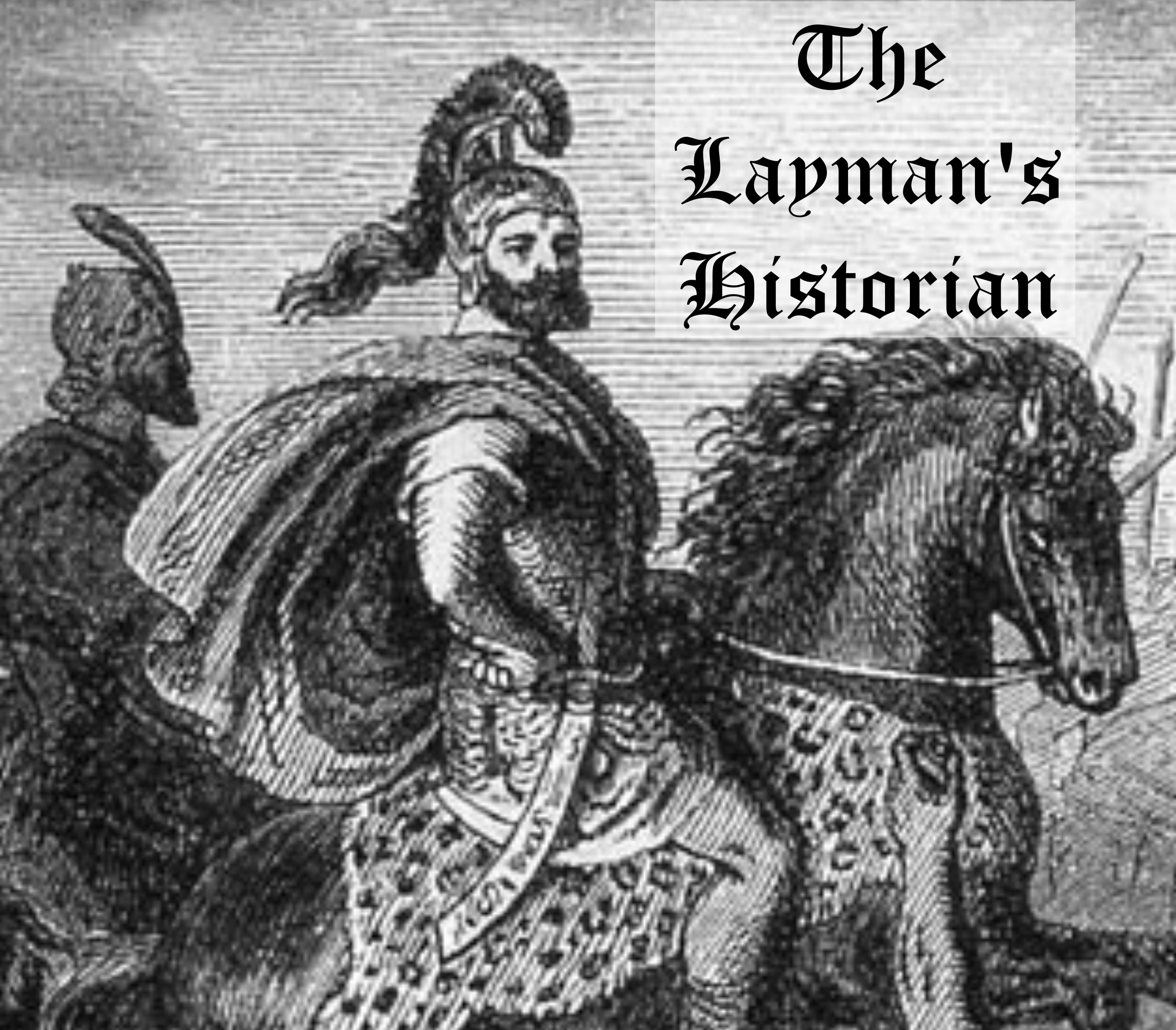Episodes

Saturday Jun 17, 2023
Episode 52 - The Fall of Carthage
Saturday Jun 17, 2023
Saturday Jun 17, 2023
The Romans might have expected to destroy Carthage easily, but they soon met surprisingly determined opposition from the Punic defenders. What was supposed to be a quick campaign dragged on into a lengthy and bloody siege with skillful Carthaginian counterattacks and sallies. Only when Scipio Aemilianus, adopted grandson of the great Africanus, arrived to supreme command did the tide begin to turn. Even so, the final moments of Carthage would resonate long after her capital was reduced to ruins.
Link to the Episode 52 page on the Layman's Historian website
Recommended further reading:
The Histories by Polybius
Hannibal's War by Titus Livius
A Companion to the Punic Wars (Blackwell Companions to the Ancient World) Edited by Dexter Hoyos
The Fall of Carthage by Adrian Goldsworthy
Hannibal's Dynasty by Dexter Hoyos
Carthage Must Be Destroyed by Richard Miles
Implacable Enemies: The Barcid Armies at War by Karwansary Publishers
Clash of the Colossi: The First Punic War by Karwansary Publishers
Subscribe or leave a review on iTunes or Spotify
Leave a like or comment on Facebook or Twitter
Contact me directly through email

Saturday Feb 18, 2023
Episode 51 - Carthago Delenda Est
Saturday Feb 18, 2023
Saturday Feb 18, 2023
The thirty years following the deaths of Scipio and Hannibal saw Carthage revive economically. Relations with Rome and Numidia, however, remained strained to the utmost, especially due to the Numidian King Masinissa's continued encroachment on Carthaginian territory with tacit Roman approval. When the frustrated Carthaginians finally struck a blow to defend their land, Rome seized the opportunity to invade and finish her rival off - once and for all.
Check out The Warlords of History Podcast website
Link to the Episode 51 page on the Layman's Historian website
Recommended further reading:
The Histories by Polybius
Hannibal's War by Titus Livius
A Companion to the Punic Wars (Blackwell Companions to the Ancient World) Edited by Dexter Hoyos
The Fall of Carthage by Adrian Goldsworthy
Hannibal's Dynasty by Dexter Hoyos
Carthage Must Be Destroyed by Richard Miles
Implacable Enemies: The Barcid Armies at War by Karwansary Publishers
Clash of the Colossi: The First Punic War by Karwansary Publishers
Subscribe or leave a review on iTunes or Spotify
Leave a like or comment on Facebook or Twitter
Contact me directly through email

Saturday Oct 01, 2022
Episode 50 - End of an Era
Saturday Oct 01, 2022
Saturday Oct 01, 2022
The disaster of Zama left Carthage in political turmoil. In the years which followed, Hannibal was able to achieve a series of ambitious reforms which led to a remarkably fast economic recovery for Carthage. His autocratic nature soon excited jealousy from his fellow aristocrats though, and with Rome's help, Hannibal was forced into exile. After a long series of flights from one eastern court to the next, the Romans at last tracked him down in the mountainous kingdom of Bithynia. His death closes the final chapter of the Second Punic War.
Link to the Episode 50 page on the Layman's Historian website
Recommended further reading:
The Histories by Polybius
Hannibal's War by Titus Livius
A Companion to the Punic Wars (Blackwell Companions to the Ancient World) Edited by Dexter Hoyos
Hannibal's Dynasty by Dexter Hoyos
Carthage Must Be Destroyed by Richard Miles
Implacable Enemies: The Barcid Armies at War by Karwansary Publishers
Clash of the Colossi: The First Punic War by Karwansary Publishers
Subscribe or leave a review on iTunes or Spotify
Leave a like or comment on Facebook or Twitter
Contact me directly through email

Friday Jul 01, 2022
Episode 49 -Zama: Battle of Giants
Friday Jul 01, 2022
Friday Jul 01, 2022
With Hannibal’s recall to Africa, we finally reach the final showdown of the Second Punic War. Scipio and his disgraced survivors of Cannae faced Hannibal’s veterans of Italy on the plains of Zama. The victor would decide the war – and the course of history.
Link to the Episode 49 page on the Layman's Historian website
Recommended further reading:
The Histories by Polybius
Hannibal's War by Titus Livius
A Companion to the Punic Wars (Blackwell Companions to the Ancient World) Edited by Dexter Hoyos
Hannibal's Dynasty by Dexter Hoyos
Carthage Must Be Destroyed by Richard Miles
Implacable Enemies: The Barcid Armies at War by Karwansary Publishers
Clash of the Colossi: The First Punic War by Karwansary Publishers
Subscribe or leave a review on iTunes or Spotify
Leave a like or comment on Facebook or Twitter
Contact me directly through email

Saturday Apr 09, 2022
Episode 48 - End of the Road
Saturday Apr 09, 2022
Saturday Apr 09, 2022
Following the disaster at the Metaurus, Hannibal retreated to southern Italy. Unable to defeat him openly yet fearful to leave him unopposed, the Roman Senate engaged in a fierce debate with the brilliant Publius Cornelius Scipio who had recently returned from Spain. In a tense showdown, Scipio convinced a grudging Senate to authorize an invasion of North Africa. While politicking with the turbulent Numidian kingdoms and establishing his ally Massinissa on the throne, Scipio also managed to crush the last Carthaginian field army between himself and Carthage. With no other cards left, the Carthaginian Senate recalled Hannibal for a final showdown with his Roman nemesis...
Link to the Episode 48 page on the Layman's Historian website
Recommended further reading:
The Histories by Polybius
Hannibal's War by Titus Livius
A Companion to the Punic Wars (Blackwell Companions to the Ancient World) Edited by Dexter Hoyos
Hannibal's Dynasty by Dexter Hoyos
Carthage Must Be Destroyed by Richard Miles
Implacable Enemies: The Barcid Armies at War by Karwansary Publishers
Clash of the Colossi: The First Punic War by Karwansary Publishers
Subscribe or leave a review on iTunes or Spotify
Leave a like or comment on Facebook or Twitter
Contact me directly through email

Friday Jan 28, 2022
Episode 47- Last Gasp at the Metaurus
Friday Jan 28, 2022
Friday Jan 28, 2022
In the bitter and bewildering struggle during the years after Cannae, Rome at last gained the upper hand. However, Hannibal would be afforded one last chance to turn the tide of the war. This was the arrival of his brother, Hasdrubal, with a great army of mercenaries in northern Italy in 207 BC. As the two brothers attempted to join forces, the Romans would execute an audacious plan to corner Hasdrubal by the banks of the Metaurus before he could unite with his elder brother....
Link to the Episode 47 page on the Layman's Historian website
Recommended further reading:
The Histories by Polybius
Hannibal's War by Titus Livius
A Companion to the Punic Wars (Blackwell Companions to the Ancient World) Edited by Dexter Hoyos
Hannibal's Dynasty by Dexter Hoyos
Carthage Must Be Destroyed by Richard Miles
Implacable Enemies: The Barcid Armies at War by Karwansary Publishers
Clash of the Colossi: The First Punic War by Karwansary Publishers
Subscribe or leave a review on iTunes or Spotify
Leave a like or comment on Facebook or Twitter
Contact me directly through email

Friday Nov 05, 2021
Episode 46 - No Easy Way Out
Friday Nov 05, 2021
Friday Nov 05, 2021
While the conflicts in Spain and Sicily raged, Hannibal still clung tenaciously to the gains he had made in Italy. In the years following Cannae, he would experience a dizzying array of successes and setbacks against the Romans ranging from failed alliances with Macedon to the capture and recapture of major Italian cities. Even so, as the years wore on, the scales of Fortune seemed ever more inclined towards Rome....
Link to the Episode 46 page on the Layman's Historian website
Recommended further reading:
The Histories by Polybius
Hannibal's War by Titus Livius
A Companion to the Punic Wars (Blackwell Companions to the Ancient World) Edited by Dexter Hoyos
Hannibal's Dynasty by Dexter Hoyos
Carthage Must Be Destroyed by Richard Miles
Implacable Enemies: The Barcid Armies at War by Karwansary Publishers
Clash of the Colossi: The First Punic War by Karwansary Publishers
Subscribe or leave a review on iTunes or Spotify
Leave a like or comment on Facebook or Twitter
Contact me directly through email

Saturday Sep 04, 2021
Episode 45 - The Mediterranean on Fire: Sicily
Saturday Sep 04, 2021
Saturday Sep 04, 2021
Unlike Spain, Sicily had been relatively quiet during the opening years of the Second Punic War. That all changed in 216 BC with the death of Hiero II, King of Syracuse. Staunchly pro-Roman, Hiero had feared that his grandson and natural heir, Hieronymus, would lead Syracuse to disaster. His greatest fears were justified - shortly after the old king's death, Hieronymus broke with Rome and allied with Hannibal. When Hieronymus was assassinated, one of the most confused and confusing conflicts of the Second Punic War began, one which would ultimately culminate in the sacking of the greatest Greek city in Magna Graecia.
Link to the Episode 45 page on the Layman's Historian website
Recommended further reading:
The Histories by Polybius
Hannibal's War by Titus Livius
A Companion to the Punic Wars (Blackwell Companions to the Ancient World) Edited by Dexter Hoyos
Hannibal's Dynasty by Dexter Hoyos
Carthage Must Be Destroyed by Richard Miles
Implacable Enemies: The Barcid Armies at War by Karwansary Publishers
Clash of the Colossi: The First Punic War by Karwansary Publishers
Subscribe or leave a review on iTunes or Spotify
Leave a like or comment on Facebook or Twitter
Contact me directly through email

Saturday Jul 17, 2021
Episode 44 - The Mediterranean on Fire: Spain
Saturday Jul 17, 2021
Saturday Jul 17, 2021
With Hannibal immersed in the mire of Italian geopolitics, the Second Punic War shifts to theaters overseas. Keenly aware of the strategic importance of maintaining pressure on Carthage’s outposts in Spain, the Scipio brothers – Gnaeus and Publius Cornelius – grappled with Hannibal’s younger brother, Hasdrubal Barca for years, chipping away at the Barcid power base. When both Scipio brothers perished within days of each other in 211 BC, Publius Cornelius Scipio the Younger volunteered to take their place as senior commander of the Spanish war. Barely in his mid-twenties, Scipio rapidly showed that he was a new type of Roman commander, one well-versed in the tactics of Hannibalic warfare….
Link to the Episode 44 page on the Layman's Historian website
Recommended further reading:
The Histories by Polybius
Hannibal's War by Titus Livius
A Companion to the Punic Wars (Blackwell Companions to the Ancient World) Edited by Dexter Hoyos
Hannibal's Dynasty by Dexter Hoyos
Carthage Must Be Destroyed by Richard Miles
Implacable Enemies: The Barcid Armies at War by Karwansary Publishers
Clash of the Colossi: The First Punic War by Karwansary Publishers
Subscribe or leave a review on iTunes or Spotify
Leave a like or comment on Facebook or Twitter
Contact me directly through email

Saturday Jul 17, 2021
Episode 43 - Capua: Hannibal's Albatross
Saturday Jul 17, 2021
Saturday Jul 17, 2021
Following Cannae, Hannibal descended into the rich agricultural lands of Campania in Magna Graecia. Chafing under Roman rule and eager to reclaim her place as hegemon of southern Italy, the ancient Etruscan city of Capua quickly came to an agreement with Hannibal. In exchange for defecting to the Carthaginian side, Hannibal would allow Capua autonomy, secure her place as mistress of Italy, and allow her to be governed by her own rulers and marshal her own army. A stormy honeymoon followed, with Hannibal soon realizing that he had given too much and received far too little for his new southern Italian "ally"....
Link to the Episode 43 page on the Layman's Historian website
Recommended further reading:
The Histories by Polybius
Hannibal's War by Titus Livius
A Companion to the Punic Wars (Blackwell Companions to the Ancient World) Edited by Dexter Hoyos
Hannibal's Dynasty by Dexter Hoyos
Carthage Must Be Destroyed by Richard Miles
Implacable Enemies: The Barcid Armies at War by Karwansary Publishers
Clash of the Colossi: The First Punic War by Karwansary Publishers
Subscribe or leave a review on iTunes or Spotify
Leave a like or comment on Facebook or Twitter
Contact me directly through email

